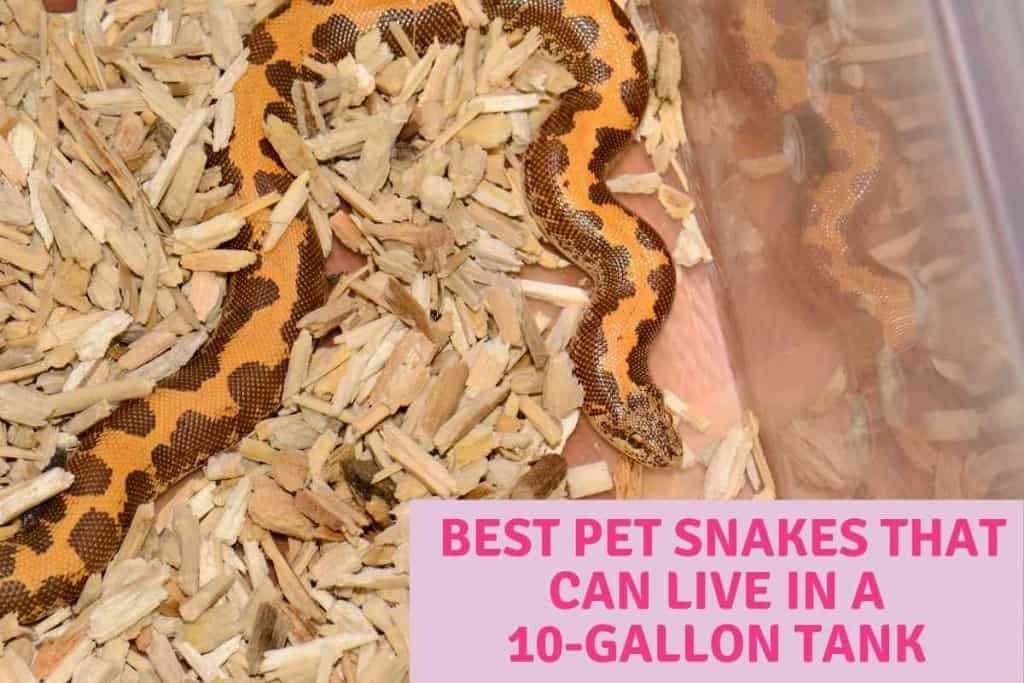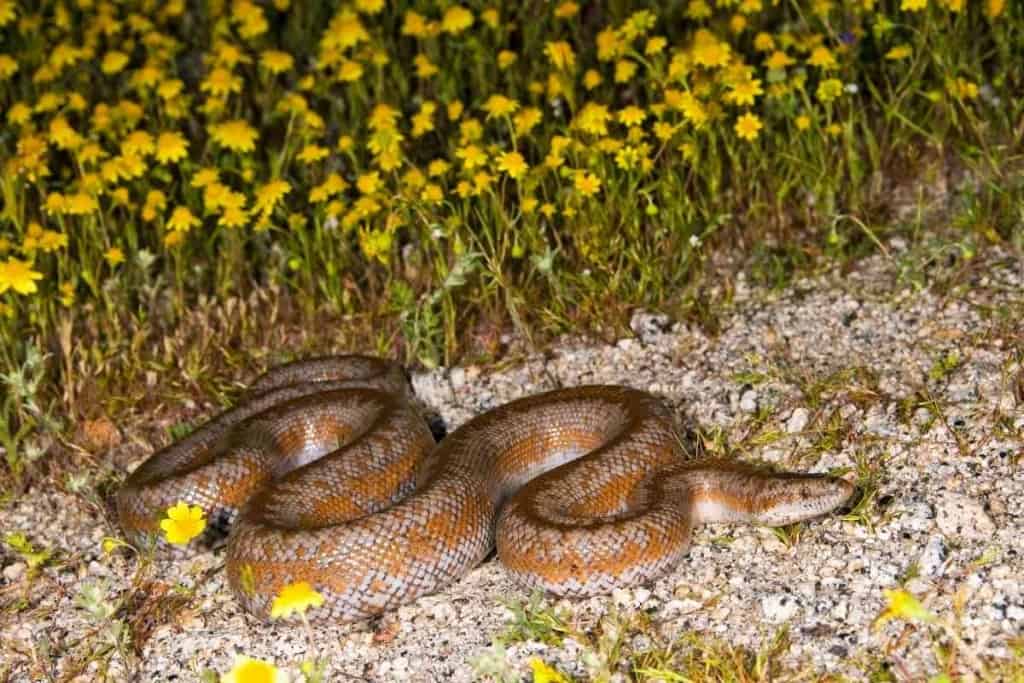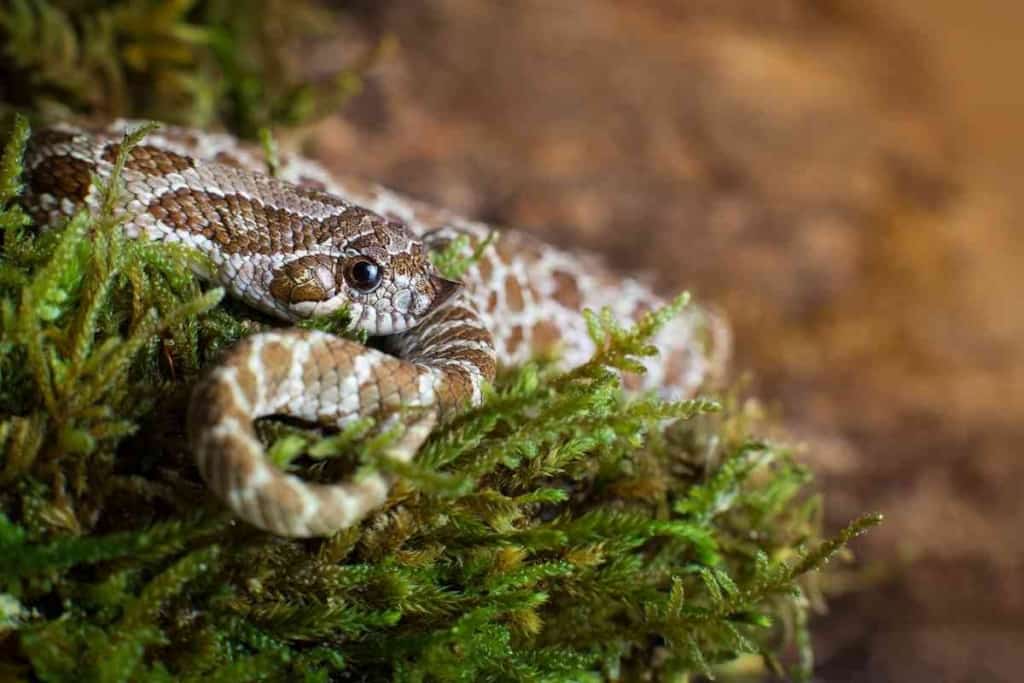5 Best Pet Snakes That Can Live In A 10-Gallon Tank
If you are considering getting a snake and you only have a 10-gallon tank, it is important to know what snakes can comfortably live in a 10-gallon tank. You may be looking at many species of snakes, but you want to ensure that if you only have room for a 10-gallon tank, you will need to purchase a snake that will be happy and thrive in a 10-gallon tank.

What are some good pet snakes that can live in a 10-Gallon tank?
We rank the rosy boa, male Kenyan sand boa, rubber boa, western hognose snake, and African house snake as the best snakes to live in a 10-gallon tank. These snakes reach a small size at full maturity, are easy to handle, and do not require extensive care.
It is important to always put a snake in a tank size that fits their size and needs. If a snake is not in the proper environment, it can suffer both mentally and physically.
The species of snakes below have been kept in 10-gallon tanks by people for many years and have shown that they can thrive and live long, happy lives in that size of enclosure.
Snakes can make great indoor pets. If you have the proper knowledge on how to care for a snake, then with the right size tank, they can live for many years and live a very happy and comfortable life.
| Related Article |
| What Snakes Can Live In A 20-Gallon Tank? |
1. Rosy Boa

The Rosy Boa, scientifically known as the Lichanura Trivirgata, is a great choice for a 10-gallon tank. This species of snake enjoys spending its time coiled up, which makes it a great fit for a smaller glass tank.
Native to the California sections of the Mojave and Colorado deserts, they can also be found in the southwest corner of Arizona and the Mexican state of Sonora. They are typically light grey, yellow, or tan with deep maroon, orange, or brown stripes of color.
At full maturity, they will typically reach a size of about 3 feet for some females and 1.5 feet for males. They usually only weigh approximately one pound.
Rosy Boas are known to be easy to care for and tolerate being handled very well. Their biggest specification for care is the temperature inside of their tank.
It is important to keep the basking side of their tank around 90 degrees Fahrenheit. The ambient side of the tank should be kept around 80 degrees Fahrenheit. You will want to keep their tank around 40-50% humidity.
The Rosy Boa is known to be a great eater in captivity, which makes them an excellent choice for a smaller tank. They typically feed on small mice and rats, but will also prey on lizards and amphibians. When they are young, they will feed approximately once per week, but as mature adults they only need to be fed every 10-14 days.
2. Male Kenyan Sand Boa
Only the male Kenyan sand boa is mentioned due to the fact that the males stay much smaller than the females. The male, which only grows to approximately 15 inches, can easily fit into a 10-gallon tank, but due to the size of the females, they will most likely need a tank that is approximately 20 gallons.
As the name suggests, the male Kenyan sand boa, scientifically known as G. colubrinus loveridgei, is from the eastern parts of Kenya. The Kenyan sand boa is unique in appearance with an orange body and a dark brown pattern. They are stout and very round in shape, which tapers to a stubby-shaped tail.
The Kenyan sand boa is known to be very docile and is comfortable being handled frequently. Because they burrow, they will tend to hide if frightened and never strike.
Kenyan sand boas prefer a sand/soil mix for substrate as they are naturally burrowing snakes. They prefer a basking temperature of 90 to 95 degrees Fahrenheit and an ambient temperature of 75 to 80 degrees Fahrenheit. The humidity of the tank should be kept between 30-40% at all times.
They will typically do well being fed small mice. Those that are juveniles under two years of age will usually be fed once per week and mature adults will be fed every 10-14 days.
3. Rubber Boa
The rubber boa is a great choice for a 10-gallon tank. There are actually two species of rubber boa, the southern rubber boa and the northern rubber boa.
The southern rubber boa, scientifically known as the Charina umbratica, is found in certain areas of Southern California. The similar northern rubber boa, scientifically known as Charina bottae, is found in a wider range of areas including Southern California all the way to British Columbia. It is also found in Idaho, western Wyoming, central Montana, northern Nevada, and Utah.
The rubber boa is a good size for a smaller tank as adult males only grow to approximately 18 to 21 inches in length.
Adult females are slightly larger at approximately 23 to 26 inches in length. The appearance of a rubber boa is unique due to its loose and wrinkly skin. They also have smooth and shiny scales. Typical coloring for the rubber boa includes tan to brown but also can be olive-green, yellow, or orange.
The rubber boa is typically a burrowing snake and will hide frequently under rocks and logs. They make a great snake for a small enclosure as they are a friendly breed of snake and tend to be extremely gentle.
Since rubber boas like to burrow, it is important to have the proper substrate available to them. Shredded newspapers can be a great substrate, but it is also important to provide excellent hiding places for them as well.
Something as simple as a stack of folded newspapers would work perfectly. They tend to prefer snug hiding places versus an open-ended log.
Rubber boas do not do well in overly warm temperatures and it can be fatal to them, but cold temperatures are also harmful to snakes.
In the basking area of their enclosure, the temperature should not exceed 85 degrees. On the ambient side, temperatures can reach as low as 65 degrees, but a good temperature range would be 70-75 degrees.
The rubber boa can be fed a diet of mice, similar to many other snakes kept in captivity. If the rubber boa is smaller, then it will need to be fed younger mice. They are unique in their feeding due to not striking as a typical snake will.
They tend to take their time during feeding and will occasionally shy away in the wild from fast-moving prey. It is important to be aware of this so you are not concerned if the snake does not go after its prey immediately in a typical feeding manner.
If rubber boas are not happy in their environment, they are known to try to escape their enclosure. Be sure to secure the lid to their enclosure snugly. If you notice your rubber boa escaping, this could mean they are stressed and trying to find somewhere safe to hide.
4. Western Hognose Snake

The western Hognose snake, scientifically known as Heterodon nasicus, is one of a few different species of Hognose snake, but the most common species to be kept in captivity.
The western hognose snake typically reached approximately 2-3 feet in length with the males being slightly smaller than the females. A male western hognose snake would be a better choice for a 10-gallon tank.
They are typically found in the states of South Dakota, Nebraska, Kansas, Oklahoma, Texas, New Mexico, Colorado, and West Virginia. They can also live in certain regions of Canada as well.
The appearance of a western hognose snake is unique in that they have an upturned scale at the tip of its nose that will help them dig through loose soil or sand. Typically they are grey or tan in color with dark blotches covering their back and they usually have a black underside.
The western hognose snake would make a great choice as a first pet snake species or pet for someone due to the typically gentle demeanor of these snakes. Interestingly, they are considered venomous, but will not harm humans.
They use their venom to kill their prey, which includes small mice as well as toads. If their venom was to get on a human, it would only cause minor skin irritation, but they are not known to be aggressive.
Typically when threatened, the western hognose snake will actually play dead to cause predators to lose interest. They will flip on their back, open their mouths, and stick their tongue to give a genuine appearance of being dead.
The environment of a western Hognose snake is fairly easy to maintain. They enjoy a substrate such as soil or sand. The basking side of their enclosure should be approximately 85-90 degrees Fahrenheit and the ambient side should be slightly cooler, but not below 75 degrees Fahrenheit.
Hognose snakes prefer to feed on toads, but will also feed on small mice as well. If you find that your snake does not seem to like mice, some people will rub the mice against a toad to get the toad scent onto the mice. This may encourage the snake to feed on the mice more willingly.
5. African House Snake
The African House Snake, scientifically known as Boaedon fuliginosus is native to sub-Saharan Africa.
The African house snake makes an excellent first-time snake as they are typically quite calm and easy to care for. The males will reach approximately 2 to 3, while the females reach 3 to 4 ½ feet.
The males are a better option to keep in a smaller 10-gallon tank. This snake is typically very subtle in appearance with shades of brown and occasionally some light spots and stripes down its body.
African house snakes require fairly typical care in regards to a snake. It is important to have a great substrate, to begin with. For the African house snake, beech or aspen wood chips will work great.
If you are looking for something even more basic, you can always use shredded newspaper or shredded paper towels as well.
This species of snake loves to climb so if you can add anything with height into their enclosure, that will help stimulate them and create a more natural environment for this species. The basking side of their enclosure should be approximately 90 degrees Fahrenheit and the ambient side can be cooler at around 70-75 degrees Fahrenheit. When it comes to humidity, 30-50% humidity is ideal for the African house snake.
African house snakes will feed on mice, which also contributes to them being easy to care for. If you have a young African house snake, they will need to feed on pinky mice and be fed one to two times per week.
An adult African house snake will only need to be fed once per week to once every two weeks. It is a good idea to start the snake young by eating prey that has been frozen and thawed. It is much safer for your snake if they are used to eating prey that is already dead.
What If You Use a Tank That Is Too Small?
Snakes need an appropriate size of tank. This is why it is so important to know the size that your species of snake will grow to. If you only have room for a certain size of tank, then you need to be sure the snake will fit into that size of tank at full maturity.
Not giving a snake the proper size of tank is detrimental to their health in the long run.
A tank that is too small can cause the snake unnecessary stress. They need the proper amount of space to feed, sleep, and relax. Without this, they can become ill from the amount of stress their body is put under.
Snakes prefer to somewhat hunt their prey. If the tank is too small and the snake is having to climb all over the prey to feed then it is not enjoyable for them.
If they do not have space to stretch out and explore then they will most likely become lethargic and lay in one place all of the time.
Snakes that are unhappy in their enclosures may attempt to escape. If you notice your snake is constantly trying to get out of their enclosure or is actually escaping, it is time to evaluate their environment and ensure that they are in a proper enclosure for them with the right amount of space and proper care for that particular species.
How Often to Clean The Tank
If you are planning to have a snake in a smaller 10-gallon tank, then you may need to do cleaning more frequently. It will be easier for them to quickly soil a smaller enclosure than if you had a snake in a very large environment.
It is important to check the tank daily to refill water and remove any feces or shed skin. If the snake has been fed recently and did not finish all of the food, you can go ahead and remove any food that was left behind as well.
It is better to not stress the snake with thorough cleanings too frequently. However, once per week the tank will most likely need a thorough cleaning. You will want to remove the snake from its habitat to do this.
It is important to wipe down and disinfect all surfaces, replace any dirty substrate with clean substrate and also clean off any toys that the snake has.
Once per month, it is recommended to do a complete cleaning of the enclosure. This is the time to really scrub every inch of the tank with a proper disinfectant. You can use a sponge or toothbrush to clean the corners and edges.
At this time, you will replace all the substrate with clean, new substrate. Soak any toys or rocks with disinfectant as well.
This is a good time to change up the enclosure and move toys or climbing objects around to give your snake something new to explore.
Safe cleaning products to use can include dish soap to scrub the tank initially. Following this, you will most likely want to use a bleach solution to disinfect everything. A bleach solution of ½ cup of bleach to one gallon of water will work well.
After you use the bleach solution you can rinse everything with hot water, let it dry and then air it out. It is important to let the tank completely dry and air out before putting the snake back inside.
